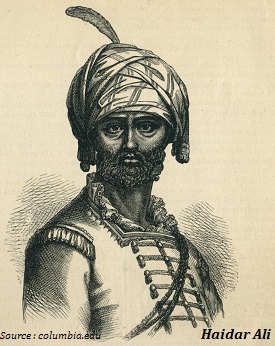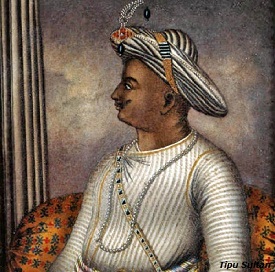
- Modern Indian History Tutorial
- Modern Indian History - Home
- Decline of Mughal Empire
- Bahadur Shah I
- Jahandar Shah
- Farrukh Siyar
- Muhammad Shah
- Nadir Shah’s Outbreak
- Ahmed Shah Abdali
- Causes of Decline of Mughal Empire
- South Indian States in 18th Century
- North Indian States in 18th Century
- Maratha Power
- Economic Conditions in 18th Century
- Social Conditions in 18th Century
- Status of Women
- Arts and Paintings
- Social Life
- The Beginnings of European Trade
- The Portuguese
- The Dutch
- The English
- East India Company (1600-1744)
- Internal Organization of Company
- Anglo-French Struggle in South India
- The British Conquest of India
- Mysore Conquest
- Lord Wellesley (1798-1805)
- Lord Hastings
- Consolidation of British Power
- Lord Dalhousie (1848-1856)
- British Administrative Policy
- British Economic Policies
- Transport and Communication
- Land Revenue Policy
- Administrative Structure
- Judicial Organization
- Social and cultural Policy
- Social and Cultural Awakening
- The Revolt of 1857
- Major Causes of 1857 Revolt
- Diffusion of 1857 Revolt
- Centers of 1857 Revolt
- Outcome of 1857 Revolt
- Criticism of 1857 Revolt
- Administrative Changes After 1858
- Provincial Administration
- Local Bodies
- Change in Army
- Public Service
- Relations with Princely States
- Administrative Policies
- Extreme Backward Social Services
- India & Her Neighbors
- Relation with Nepal
- Relation with Burma
- Relation with Afghanistan
- Relation with Tibet
- Relation with Sikkim
- Relation with Bhutan
- Economic Impact of British Rule
- Nationalist Movement (1858-1905)
- Predecessors of INC
- Indian National Congress
- INC & Reforms
- Religious & Social Reforms
- Religious Reformers
- Women’s Emancipation
- Struggle Against Caste
- Nationalist Movement (1905-1918)
- Partition of Bengal
- Indian National Congress (1905-1914)
- Muslim & Growth Communalism
- Home Rule Leagues
- Struggle for Swaraj
- Gandhi Assumes Leadership
- Jallianwalla Bagh Massacre
- Khilafat & Non-Cooperation
- Second Non-Cooperation Movement
- Civil Disobedience Movement II
- Government of India Act (1935)
- Growth of Socialist Ideas
- National Movement World War II
- Post-War Struggle
- Clement Attlee’s Declaration
- Reference & Disclaimer
Modern Indian History - Mysore Conquest
For British, Haidar Ali was one of the biggest problems in south India; without defeating Haidar Ali, it was not possible for the British to control the southern states.
Haidar Ali
In 1766, British entered into an alliance with the Nizam of Hyderabad to protect him from Haidar Ali (of Mysore) in return for the secession of the Northern Sarkars.

Haidar Ali was more than a match for the Company's armies. Having beaten back the British attack, he threatened Madras in 1769 and forced the Madras Council to sign a peace on his terms. Both sides restored each other's conquests and promised mutual help in case of attack by a third party.
In 1771, when Haidar Ali was attacked by the Marathas, the English went back on their promise and did not come to his help. This led Haidar Ali to distrust and dislike them.
In 1775, the English clashed with the Marathas, which lasted in 1782.
In the English and Maratha war, all the Maratha chiefs were united behind the Peshwa and their chief minister, Nana Phadnavis.
The Southern Indian powers had long been resenting the presence of the British among them, and Haidar Ali and the Nizam chose this moment to declare war against the British Company.
The British in India were, however, led at this time by their brilliant, energetic, and experienced Governor-General, Warren Hastings.
Acting with firm determination, he retrieved the vanishing British power and prestige.
The English had found in the Marathas a determined enemy, with immense resources. Mahadji Sindhia had given evidence of his power which the English dreaded to contest.
The Anglo-Maratha War had come to a standout. With the intercession of Mahadji, peace was concluded in 1782 by the Treaty of Salbai by which the status quo was maintained.
This war, known in history as the First Anglo-Maratha War, did not end in victory for either side. But it did give the British 20 years of peace with the Marathas, the strongest Indian power of the day.
The British utilized the period of 20 years to consolidate their rule over the Bengal Presidency, while the Maratha chiefs frittered away their energy in bitter mutual squabbles.
The Treaty of Salbai enabled the British to exert pressure on Mysore as the Marathas promised to help them in recovering their territories from Haidar Ali.
In July 1781, the British army under Eyre Coote defeated Haidar Ali at Porte Novo and saved Madras.
Tipu Sultan
After Haidar Ali’s death in December 1782, the war was carried on by his son, Tipu Sultan. Since neither side was capable of overpowering the other, peace was signed by them in March 1784 and both sides restored all conquests.

The peace of 1784 had not removed the grounds for struggle between Tipu and the British; it had merely postponed the struggle.
The authorities of the East India Company were acutely hostile to Tipu. They looked upon him as their most formidable rival in the South and as the chief obstacle standing between them and complete domination over South India.
Tipu, on his part, thoroughly disliked the English, saw them as the chief danger to his own independence, and nursed the ambition to expel them from India.
Even though Tipu fought with exemplary bravery, Lord Cornwallis, the then Governor-General, had succeeded through shrewd diplomacy in isolating him by winning over the Marathas, the Nizam, and the rulers of Travancore and Coorg.
This war again revealed that the Indian powers were shortsighted enough to aid the foreigner against another Indian power for the sake of temporary advantages.
By the Treaty of Seringapatam (1792), Tipu ceded half of his territories to the allies and paid 330 lakhs of rupees as indemnity.
The Third Anglo-Mysore war destroyed Tipu's dominant position in the South and firmly established British supremacy there.